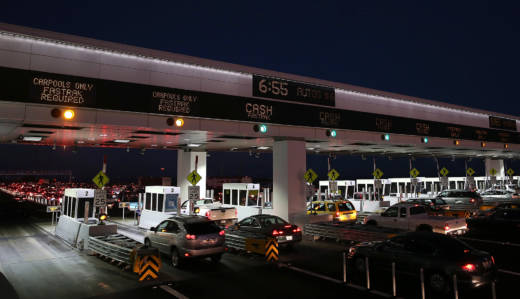By the way, that last option already has what might turn out to be a campaign nickname: "One plus one plus one."
The survey found regional support for all three options, with 56 percent saying they'd support the $1 hike, 57 percent supporting the $2 increase and 52 percent backing the $3 rise. Those numbers were higher when respondents had heard more about what the tolls would pay for: 60 percent said they'd vote for a $1 or $3 increase, with 64 percent backing the $2 increase.
The toll increases also appear to enjoy substantial support among those who would be paying them every day.
The poll found that frequent toll payers -- those who use the bridges at least once a week -- back all three increase scenarios with at least 55 percent backing. The same held true for occasional toll payers and those who rarely or never cross the bridges.
"I think it's fair to say we were pleasantly surprised by the degree of support," Jake Mackenzie, a Rohnert Park City Council member who represents Sonoma County and serves as MTC chair, said after a public workshop on Regional Measure 3 on Wednesday.
He said he felt that the apparent backing of the toll increases reflects public understanding that the Bay Area will need to pay its own way for transportation improvements.
"I’m not sure what help we’re going to continue to get from the federal government -- they talk about an infrastructure bill," Mackenzie said. "But this is basically self-help Bay Area, self-help California."
RM3 would require a simple regional majority to pass -- 50 percent plus one vote among all ballots cast in the nine-county region.
The toll plan was most popular in Alameda, San Francisco and San Mateo counties, with 60 percent or more saying yes to the $1 and $2 scenarios and between 52 and 59 percent supporting a $3 increase.
There's substantially less enthusiasm for the increases in three counties: Contra Costa, Napa and Solano.
Some elected officials in Contra Costa, including Rep. Mark DeSaulnier and Assemblyman Tim Grayson, have argued that East Bay residents will pay significantly more in increased tolls than their communities will get back in benefits.
The MTC poll found that just 44 percent of Contra Costa respondents would support a $3 toll increase, while 46 percent would back a $1 bump and 47 percent a $2 hike.
Napa/Solano respondents were similarly cool to the toll increases, with support for the increases in the 42 percent to 46 percent range.
The hybrid telephone-web poll included responses from 4,151 people who identified themselves as likely to vote in the June 2018 primary. The sample was weighted to reflect the expected June nine-county electorate. The margin of error for the overall sample was plus or minus 2.6 percentage points; the error margin for each county or subregion was plus or minus 4 percentage points.
Other key poll findings:
- Respondents were evenly split -- at 42 percent -- on the question of whether the region is "generally going in the right direction ... or pretty seriously on the wrong track.
- Respondents' top three regional concerns: Affordable housing (21 percent), traffic congestion (14 percent), homelessness (9 percent).
- Sixty percent of respondents said their primary mode of commuting is driving alone; 12 percent said they commute most often by public transportation; 1 percent named Uber or Lyft as their primary mode.
- Top transportation priorities: 79 percent of respondents ranked reducing truck congestion and improving air quality as very important or somewhat important; 76 percent said purchasing new BART cars and extending BART to Silicon Valley was very or somewhat important.
The MTC commissioners -- acting in their role as the Bay Area Toll Authority -- are expected to decide next month on the amount of the Regional Measure 3 toll increase and how it will be phased in. The deadline is in March for the Bay Area's nine county boards of supervisors to place the measure on the ballot.
